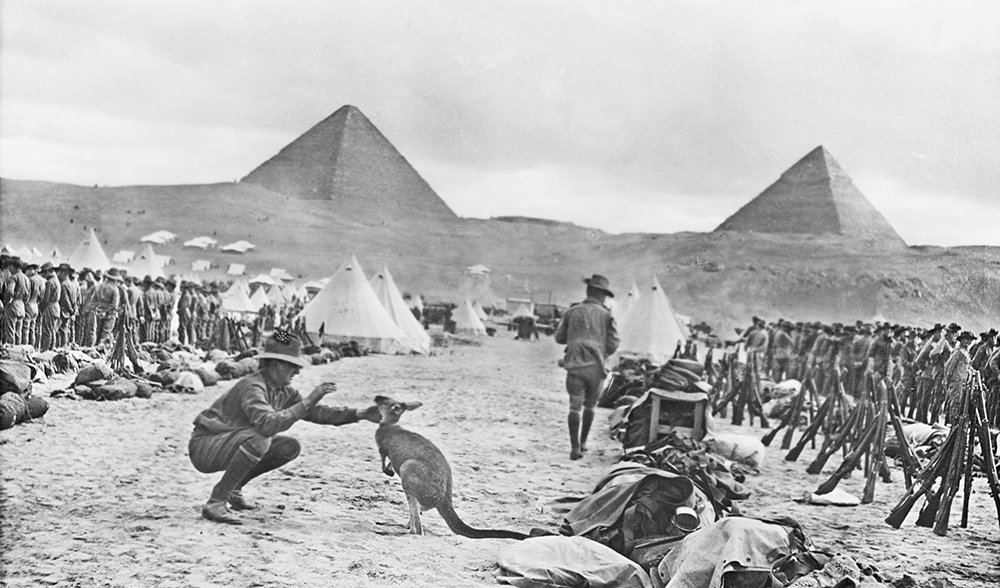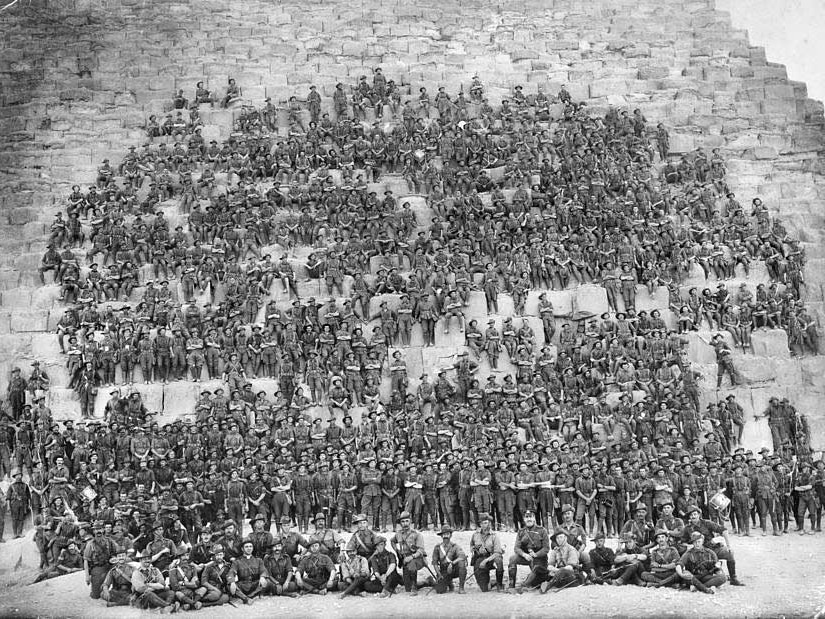The first of the ANZACs had departed Australia in early November 1914. By the end of December the vast majority of the ANZACs had arrived in Egypt, with the remainder arriving by the end of January. When they departed they had little idea how long it would be before they would be fighting, or how long the war would be. Many thought that the war would be quickly won and that volunteering would allow them to see foreign lands while proudly serving the Empire. Gallipoli, the first major campaign for Australia and New Zealand would galvanise these soldiers and officers, building their reputation as a formidable and tenacious fighting force. A reputation that would be carried by both nations into future campaigns and again later in World War II.

Image 1: Lines of the Australian 9th and 10th Battalions at Mena Camp, looking towards the Pyramids. The soldier in the foreground is playing with a kangaroo, the regimental mascot. Many Australian units brought kangaroos and other Australian animals with them to Egypt, and some were given to the Cairo Zoological Gardens when the units went to Gallipoli.
Training
On arrival in Egypt, Birdwood’s Corps Headquarters was quickly established at the Shepheard’s Hotel in Cairo. The Australian and New Zealand troops camped at Mena Camp near Cairo where initially there were only sufficient tents for 8,500 troops. The remainder of the troops slept in bivouacs until additional tents arrived two weeks later.
The Egyptian winter delivered bitterly cold nights and blistering hot days, with some men succumbing to heat stroke and pneumonia during their arduous training in full marching order six days a week. Any that were not fit to endure the training were sent to the Egyptian Army Hospital at Abassia under the care of Australian nurses. Those who didn’t recover were sent home.

Image 2: Group portrait of all the original officers and men of the 11th Battalion, 3rd Brigade, AIF. The group of over 685 soldiers are spread over the side of the Great Pyramid of Khufu (Cheops) near Mena camp. Capt Barnes records in his diary: 'After Church this morning the whole Battalion was marched up to the Pyramid (Old Cheops) and we had a photo took or at least several of them.' Amidst the training undertaken by the men, there was time on Sundays, days off and evenings when leave was granted to visit local sites of interest such as the pyramids, the Citadel and the many mosques in Cairo. The trams struggled to keep up with the demand and local transport such as carriages were heavily used. The cafes and restaurants of Cairo were also heavily patronised.
During training, Sundays were set aside for church parades and writing letters home. On Sunday afternoon many men took the time to conduct leisurely tourist activities around Cairo. With the tourist population in Egypt at an all-time low due to the outbreak of the war, the well paid Australians and New Zealanders were a welcome replacement.
By Christmas, many of the soldiers had grown bored of the sights of Cairo. PTE John Simpson wrote home to his mother in England on Christmas Day of 1914 “It is Christmas day today. I was looking forward to spending today in Shields but I was doomed to be disappointed. I would not have joined this contingent if I had known that they were not going to England. I would have taken the trip home and had a holiday at home then joined the army at home and went to the front”. Little did he know, his future actions at Gallipoli would make his name synonymous with the ANZAC spirit.
Timeline
13 January 1915 – The British War Council makes Constantinople a strategic military objective which makes the seizure of Dardanelles Strait and Gallipoli Peninsula a necessity.
15 January 1915 – A French Submarine (Saphir) is sunk in Dardanelles Strait.
25 January 1915 – 1st Australian General Hospital is opened in Cairo in preparation for the future battles in the region.
03 February 1915 – Turkish forces conduct an attack on the Suez Canal between Tussum and Serapeum expecting to cross the canal into Egypt unopposed. Indian and New Zealand outposts repel the attack. The Turks sustain significant casualties and withdraw.
16 February-03 March 1915 – British Marine units infiltrate Turkish forts at Gallipoli disabling multiple Turkish guns. The Royal Navy conduct multiple naval bombardments on the forts with varying degrees of success.
04 March 1915 – The 3rd Australian Infantry Brigade lands at Lemnos, around 100 km from the Gallipoli Peninsula. They are to become part of the occupation force if the Royal Navy successfully captures the Turkish forts along Dardanelles Strait.
06 March 1915 – A Turkish naval minelayer lays an additional 20 mines in the Dardanelles Strait.
11 March 1915 – General Sir Ian Hamilton is appointed to command the Constantinople Expeditionary Force, which is later renamed the Mediterranean Expeditionary Force to reduce the risk of revealing the Force’s scheme of manoeuvre.
13 March 1915 – Field Marshal Kitchener orders General Hamilton to undertake ground invasion only in the event of the naval fleet failing to break through the Turkish defences of Dardanelles Strait.
01-17 March 1915 – British fishing trawlers unsuccessfully attempt to clear Dardanelles Strait of mines.
18 March 1915 – 18 British and French battleships attack the Dardanelles forts. Three battleships are lost and three are disabled. Over 700 sailors perish as a result of the failed naval attempt. Naval operations are abandoned and the plan to invade Gallipoli Peninsula with a ground force is approved.
It is important to remember that at this point the soldiers and officers of the AIF had been in Egypt training for months. Boredom grew amongst the ranks as the excitement of being in a strange foreign country had waned. There were reports of minor incidents with the residents of Cairo which culminated with a considerable incident on Good Friday, 02 April 1915, that was described as a riot. Shortly after this, the ANZACs were to be landing at Gallipoli Peninsula, which would become the final resting place for many.









